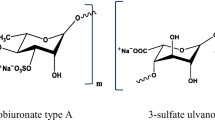Abstract
The rheological behavior of a sulfated galactan extracted from Halymenia durvillei, a red seaweed collected in the coastal waters of a small island of Madagascar (Nosy-be in Indian Ocean), was investigated in dilute and semi-dilute solutions. In dilute solution with NaCl at 0.3 M, the polysaccharide adopted a coil conformation whereas, at higher concentrations, the polymer had the behavior of shear-thinning fluid, typical of polymer with high molar mass or semi-rigid conformation. Degradations of this lambda carrageenan-like, using radical depolymerization, and high-pressure homogenization led to several samples of various and controlled molar masses. The measure of their intrinsic viscosities permitted the determination of the relationship of Mark–Houwink–Sakurada.





Similar content being viewed by others
References
Rinaudo, M. (2007). Seaweed polysaccharides. In: J. P. Kalmerling (Ed.), Comprehensive glycoscience from chemistry to systems biology, 2, 691–735
Witvrouw, M., & De Clercq, E. (1997). Sulfated polysaccharides extracted from sea algae as potential antiviral drugs. General Pharmaceuticals, 29, 497–511.
Knutsen, S., Myslabodski, D., Larsen, B., & Usov, A. (1994). A modified system of nomenclature for red algal galactans. Botanica Marina, 37, 163–169.
Rees, D. A. (1969). Structure conformation and mechanism in formation of polysaccharide gels and networks. Advances in Carbohydrate Chemistry and Biochemistry, 24, 267–332.
Hirase, S., Araki, C., & Watanabe, K. (1967). Component sugars of the polysaccharide of the red seaweed Grateloupia elliptica. Bulletin of the Chemical Society of Japan, 40, 1445–1448.
Farrant, A. J., Nuun, J. R., & Parolis, H. (1972). Sulphated polysaccahrides of the Grateloupiaceae family; Part VII. Investigation of the acetolysis products of a partially desulphated sample of polysaccharide of Pachymenia Carnosa. Carbohydrate Research, 25, 283–292.
Miller, I. J., Falshaw, R., & Furneaux, R. H. (1995). Structural analysis of the polysaccharide from Pachymenia lusoria (Cryptonemiaceae, Rhodophyta). Carbohydrate Research, 268, 219–232.
Fenoradosoa, T. A., Delattre, C., Laroche, C., Wadouachi, A., Dulong, V., Picton, L., Andriamadio, P., & Michaud, P. (2009). Highly sulphated galactan from halymenia durvillei (Halymeniales, Rhodophyta), a red seaweed of Madagascar marine coast. International Journal of Biological Macromolecules, 45, 140–145.
Volpi, N., Mascellani, G., & Bianchini, P. (1992). Low molecular weight heparins (5kDa) and oligoheparins (2kDa) Produced by gel permeation enrichment or radical process: comparison of structures and physicochemical and biological properties. Analytical Biochemistry, 200, 100–107.
Nardella, A., Chaubet, F., Boisson-Vidal, C., Blondin, C., Durand, P., & Jozefonvicz, J. (1996). Anticoagulant low molecular weight fucans produced by radical process and ion exchange chromatography of high molecular weight fucans extracted from brown seaweed Ascophyllum nodosum. Carbohydrate Research, 289, 201–208.
Yang, Z., Li, J. P., & Guan, H. S. (2004). Preparation and characterization of oligomannuronates from alginate degraded by hydrogen peroxide. Carbohydrate Polymers, 58, 115–121.
Miller, J. G., & Fry, S. C. (2001). Characteristics of xyloglucan after attack by hydroxyl radials. Carbohydrate Research, 332, 389–403.
Viebke, C., Borgstro, J., & Piculell, L. (1995). Characterization of к- and τ-carrageenan coils and helices by MALLS/GPC. Carbohydrate Polymers, 27, 145–154.
Williams, P. A., & Phillips, G. O. (2006). Gums and stabilizers for the food industry (volume 13) (p. 495). UK: Royal Society of Chemistry.
Slootmaekers, D., van Dijk, J. A. P. P., Varkevisser, F. A., van Treslong, C. J. B., & Reynaers, H. (1991). Molecular characterisation of kappa- and lambda-carrageenan by gel permeation chromatography, light scattering, sedimentation analysis and osmometry. Biophysical Chemistry, 41, 51–59.
Zhou, G., Sun, Y. P., Xin, H., Zhang, Y., Li, Z., & Xu, Z. (2004). In vivo antitumor and immunomodulation activities of different molecular weight lambda-carrageenans from chondrus ocellatus. Pharmacological Research, 50, 47–53.
Zhou, G., Xin, H., Sheng, W., Sun, Y., Li, Z., & Xu, Z. (2005). In vivo growth-inhibition of S180 tumor by mixture of 5-Fu and low molecular carrageenans from C. ocellatus. Pharmacological Research, 51, 153–157.
Guibet, M., Colin, S., Barbeyron, T., Genicot, S., Kloareg, B., Michel, G., & Helbert, W. (2007). Degradation of lambda-carrageenan by Pseudoalteromonas carrageenovora lambda-carrageenase: A new family of glycoside hydrolases unrelated to kappa- and iota-carrageenases. Biochemical Journal, 404, 105–114.
Nilsson, S., & Piculell, L. (1989). Helix-coil transitions of ionic polysaccharides analysed within the Poisson-Boltzmann cell model. 2. Effects of salt concentration on the thermal transition. Macromolecules, 22, 3011–3017.
Piculell, L. (1991). Phase separation in aqueous mixtures of similarly charged polyelectrolytes. Polymer Communications, 32, 158–160.
Piculell, L., Nilsson, S., & Strom, P. (1989). On the specificity of the binding of cations to carrageenans: Counterion N.M.R. spectroscopy in mixed carrageenan systems. Carbohydrate Research, 188, 121–135.
Utracki, L., & Shima, R. (1963). Corresponding state relations for the viscosity of moderately concentrated polymer solutions. Journal of Polymer Science, 1, 1089–1098.
Villay, A., Lakkis de Filippis, F., Picton, L., Le Cerf, D., Vial, C., & Michaud, P. (2012). Comparison of polysaccharide degradations by dynamic high pressure homogenisation. Food Hydrocolloids, 27, 278–286.
Author information
Authors and Affiliations
Corresponding author
Rights and permissions
About this article
Cite this article
Fenoradosoa, T.A., Laroche, C., Delattre, C. et al. Rheological Behavior and Non-enzymatic Degradation of a Sulfated Galactan from Halymenia durvillei (Halymeniales, Rhodophyta). Appl Biochem Biotechnol 167, 1303–1313 (2012). https://doi.org/10.1007/s12010-012-9605-z
Received:
Accepted:
Published:
Issue Date:
DOI: https://doi.org/10.1007/s12010-012-9605-z




